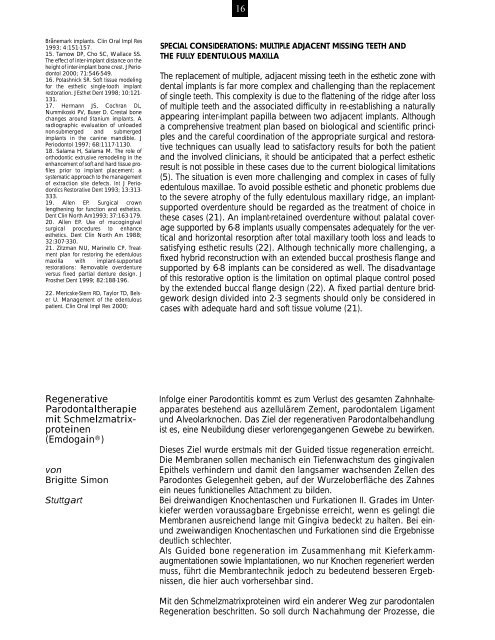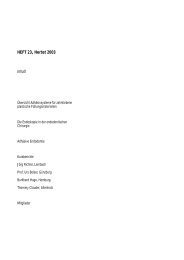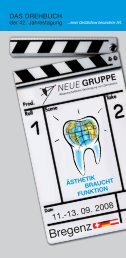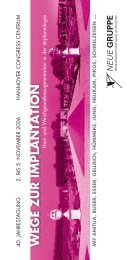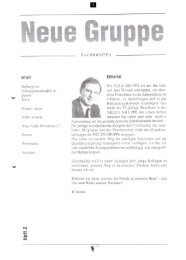Heft 19 - Herbst 2001.pdf - Neue Gruppe
Heft 19 - Herbst 2001.pdf - Neue Gruppe
Heft 19 - Herbst 2001.pdf - Neue Gruppe
Erfolgreiche ePaper selbst erstellen
Machen Sie aus Ihren PDF Publikationen ein blätterbares Flipbook mit unserer einzigartigen Google optimierten e-Paper Software.
Brånemark implants. Clin Oral Impl Res<br />
<strong>19</strong>93; 4:151-157.<br />
15. Tarnow DP, Cho SC, Wallace SS.<br />
The effect of inter-implant distance on the<br />
height of inter-implant bone crest. J Periodontol<br />
2000; 71:546-549.<br />
16. Potashnick SR. Soft tissue modeling<br />
for the esthetic single-tooth implant<br />
restoration. J Esthet Dent <strong>19</strong>98; 10:121-<br />
131.<br />
17. Hermann JS, Cochran DL,<br />
Nummikoski PV, Buser D. Crestal bone<br />
changes around titanium implants. A<br />
radiographic evaluation of unloaded<br />
n o n - s u b m e rged and submerg e d<br />
implants in the canine mandible. J<br />
Periodontol <strong>19</strong>97; 68:1117-1130.<br />
18. Salama H, Salama M. The role of<br />
orthodontic extrusive remodeling in the<br />
enhancement of soft and hard tissue profiles<br />
prior to implant placement: a<br />
systematic approach to the management<br />
of extraction site defects. Int J Periodontics<br />
Restorative Dent <strong>19</strong>93; 13:313-<br />
333.<br />
<strong>19</strong>. Allen EP. Surgical cro w n<br />
lengthening for function and esthetics.<br />
Dent Clin North Am<strong>19</strong>93; 37:163-179.<br />
20. Allen EP. Use of mucogingival<br />
s u rgical pro c e d u res to enhance<br />
esthetics. Dent Clin North Am <strong>19</strong>88;<br />
32:307-330.<br />
21. Zitzman NU, Marinello CP. Treatment<br />
plan for restoring the edentulous<br />
maxilla with implant-support e d<br />
restorations: Removable overd e n t u re<br />
versus fixed partial denture design. J<br />
Prosthet Dent <strong>19</strong>99; 82:188-<strong>19</strong>6.<br />
22. Mericske-Stern RD, Taylor TD, Belser<br />
U. Management of the edentulous<br />
patient. Clin Oral Impl Res 2000;<br />
Regenerative<br />
Parodontaltherapie<br />
mit Schmelzmatrixproteinen<br />
(Emdogain ® )<br />
von<br />
Brigitte Simon<br />
Stuttgart<br />
16<br />
SPECIAL CONSIDERATIONS: MULTIPLE ADJACENT MISSING TEETH AND<br />
THE FULLY EDENTULOUS MAXILLA<br />
The replacement of multiple, adjacent missing teeth in the esthetic zone with<br />
dental implants is far more complex and challenging than the re p l a c e m e n t<br />
of single teeth. This complexity is due to the flattening of the ridge after loss<br />
of multiple teeth and the associated difficulty in re-establishing a naturally<br />
appearing inter-implant papilla between two adjacent implants. Although<br />
a comprehensive treatment plan based on biological and scientific principles<br />
and the careful coordination of the appropriate surgical and re s t o r ative<br />
techniques can usually lead to satisfactory results for both the patient<br />
and the involved clinicians, it should be anticipated that a perfect esthetic<br />
result is not possible in these cases due to the current biological limitations<br />
(5). The situation is even more challenging and complex in cases of fully<br />
edentulous maxillae. To avoid possible esthetic and phonetic problems due<br />
to the severe atrophy of the fully edentulous maxillary ridge, an implants<br />
u p p o rted overd e n t u re should be re g a rded as the treatment of choice in<br />
these cases (21). An implant-retained overd e n t u re without palatal coverage<br />
supported by 6-8 implants usually compensates adequately for the vertical<br />
and horizontal resorption after total maxillary tooth loss and leads to<br />
satisfying esthetic results (22). Although technically more challenging, a<br />
fixed hybrid re c o n s t ruction with an extended buccal prosthesis flange and<br />
s u p p o rted by 6-8 implants can be considered as well. The disadvantage<br />
of this restorative option is the limitation on optimal plaque control posed<br />
by the extended buccal flange design (22). A fixed partial denture bridgework<br />
design divided into 2-3 segments should only be considered in<br />
cases with adequate hard and soft tissue volume (21).<br />
Infolge einer Parodontitis kommt es zum Verlust des gesamten Zahnhalteapparates<br />
bestehend aus azellulärem Zement, parodontalem Ligament<br />
und Alveolarknochen. Das Ziel der regenerativen Paro d o n t a l b e h a n d l u n g<br />
ist es, eine Neubildung dieser verlorengegangenen Gewebe zu bewirken.<br />
Dieses Ziel wurde erstmals mit der Guided tissue regeneration erre i c h t .<br />
Die Membranen sollen mechanisch ein Tiefenwachstum des gingivalen<br />
Epithels verh i n d e rn und damit den langsamer wachsenden Zellen des<br />
P a rodontes Gelegenheit geben, auf der Wu rz e l o b e rfläche des Zahnes<br />
ein neues funktionelles Attachment zu bilden.<br />
Bei dreiwandigen Knochentaschen und Furkationen II. Grades im Unterkiefer<br />
werden voraussagbare Ergebnisse erreicht, wenn es gelingt die<br />
Membranen ausreichend lange mit Gingiva bedeckt zu halten. Bei einund<br />
zweiwandigen Knochentaschen und Furkationen sind die Erg e b n i s s e<br />
deutlich schlechter.<br />
Als Guided bone regeneration im Zusammenhang mit Kieferkammaugmentationen<br />
sowie Implantationen, wo nur Knochen re g e n e r i e rt werd e n<br />
muss, führt die Membrantechnik jedoch zu bedeutend besseren Erg e bnissen,<br />
die hier auch vorhersehbar sind.<br />
Mit den Schmelzmatrixproteinen wird ein anderer Weg zur paro d o n t a l e n<br />
Regeneration beschritten. So soll durch Nachahmung der Prozesse, die


